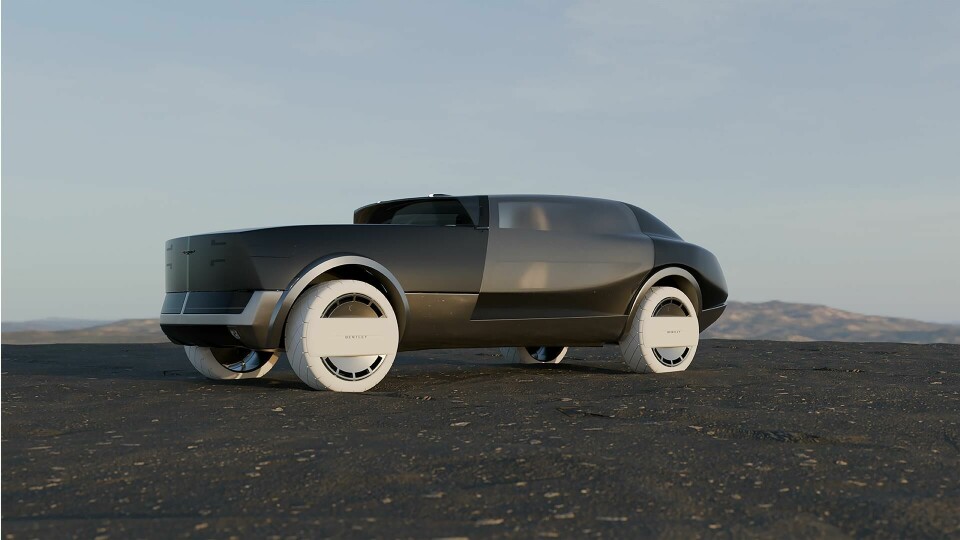
Pforzheim MA Transportation Design degree show 2025
The second feature of our two-part series looks at the work from Pforzheim’s Trasportation Design Masters students
From boat-tailed buses to airport tugs inspired by Tom Sachs streetwear, the MA students drew inspiration from all over for this year’s show. Remember, this is a transportation design course, with projects that look far beyond ‘the car’ in isolation.
If you missed the first installment, you can read that here. Like last time, this is not an exhaustive list of all students across the course, but a small selection from our visit. The list follows no particular order beyond chronological order of semester, progressing from “recently joined” to “about to graduate.”
First Semester
Vinzenz Wörtl
It is often said that certain designs look dynamic even while stationary. Supercars that appear in motion even while parked on a manicured lawn. With the proto concept, Wörtl took this concept a little further and aimed to create a vehicle that looks as though it is moving forwards even in reverse.
Indeed, two key themes are present: omnidirectionality and space travel. From his research, he found that aircraft tugs – the stocky little trucks that manoeuvre planes into position – have to travel in both directions as part of their daily life. He also recognised that these drivers are “unappreciated” and should be given a vehicle that they are proud to drive. One that even feels cool.
Drawing inspiration from revered streetwear designer Tom Sachs (head to StockX, you’ll see what we mean) seems a good start. Wörtl explains: “The main styling direction was inspired by the contemporary artist Tom Sachs and his space related-works, combined with a rough, handmade aestetic. On the final car, a main volume, remeniscent of a space capsule, is held from both sides by metal sheets that bear the look of bent, water-cut brushed steel.”
A white, grey and purple theme combines with the “unexpected red” associated with the NASA logo, restylised for this project as NSVA.
Second Semester
Francesco Pizitolla
Working to the brief dubbed “city flex cargo mobility”, Pizitolla decided to hunker down and focus on physical experiences like reading and spending time with friends. You would have likely gathered this from the name – Book me – of which the cargo is primarily books. Indeed, he describes it as a shared vehicle that is almost like an outdoor book club.
Naturally, the interior is designed in a way to support this. Passengers are not segmented in privacy, but given more of an open environment to share and discuss. ”The seat is asymmetrical,” he explains, ”allowing passengers to have two different way of reading. On the left side there is an area for having a tea while on the right there is an hidden dashboard.”
While the steering wheel can be used as lectern from which to lead discussions, there is the option for quiet contemplation as the library wall rotates for “privacy and shadow” during reading mode.
Paul Herzog
Despite openly conceding that he is not much of a cook, Herzog was inspired by the idea of a moving kitchen for this project. “It is an interior that connects people,” he told CDN.
Bringing food prep into the mix brought its own set of challenges, but in hindsight this gave a particular direction for the CMF and layout. For example, every metal surface is a shade of orange, using copper for its antimicrobial properties. For ambient lighting, UV spotlights help to sterilise elements of the interior. And just as you could find around the perimeter of a restaurant, the seats are connected to the walls not the floor, giving a sense of space.
While this is an interior project only, it is part of a wider concept around a mobility service that takes you where you need to go, but also feeds you on the way. “In this moving kitchen you are greeted by a professional chef who will provide you with foods and drinks of exceptional quality while showcasing their skill and knowledge. May your next journey be fueled by flavour!”
We trust Herzog had to suffer through the task of sampling many different restaurants as part of this, all in the name of proper and thorough research of course. Sigh, I guess somebody has to do it!
Thesis
Atamann Özolcer
“This project envisions a new design direction for Bentley,” says Özolcer. “The core idea emerges from a speculative scenario: after a catastrophic global event, humanity rebuilds a borderless world with shared resources, where flashy displays of wealth lose relevance. In this new reality, luxury becomes about authenticity, quality, and timeless design rather than excess.”
He highlights contemporary models such as the Bentayga, which in his eyes have strayed from what Bentley is – or was – all about. The concept proposes a return to “understated elegance,” drawing inspiration from iconic models like the 1939 Embiricos, Brooklands, 2002 Continental GT and 2015 Mulsanne. Inspiration also came from the1929 Bentley Speed Six Blue Train. “It’s about transcending material wealth,” he explains.
Özolcer also did a nice sketch of a Bentley for us later on, put together in just five minutes with a crowd watching. Nice work.
Anatolii Sizov
Anatolii (no, not the jacked influencer who disguises himself as a janitor) puts forward an alternative vision for compact sports cars under the Mazda nameplate.
Inspiration came directly from the brand’s heritage of such vehicles, but also from the Olympic bobsleigh, creating in his words “an innovative and distinctive” profile with a “never-seen-before experience.” Sizov refers to a unique suspended capsule at the centre of the chassis, which is able to twist and rotate as the car moves.
Electric motors at the rear bring favourable driving dynamics and a theoretrical range of 200km by Sizov’s calculations. “Mazda Tanoshii is a zero-emission tool for exciting driving,” he says. We particularly enjoyed the ‘VROOOOM’ annotation on Sizov’s poster.
Seungjun Kim
Kim took the MAN brand and reimagined the conventional coach with a new distinctive, elegant and boat-tailed design.
Showcased in a deep metallic green with sharp surfacing and enormous glasshouse, the Chronoliner coach draws inspiration from the layout of a theatre, with steps leading ot the upper deck that end up sloping down towards the front mask of the vehicle ahead of the front axles. Think about walking up to your favourite show before heading to your seat a few rows down.




































































